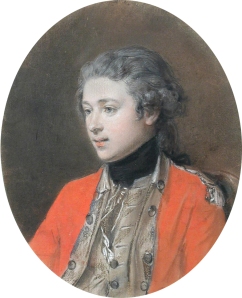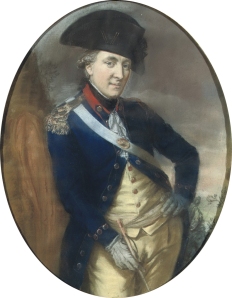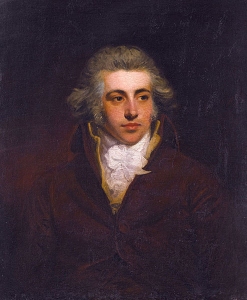Nob in need of a nerd
 Those of you who have decoded my Twitter gravatar (if that is the right term) will know that my work involves helping aristocrats in danger of losing heir heads – or more often, helping regraft them after unfortunate events. The pages of my Dictionary of pastellists consist of thousands of cases where I have been able to do this with more or less precision. Sadly too often we are left with question marks, particularly when you approach the task with the requisite scepticism to “resemblances” (see an earlier post on this blog). I find it curious to read the innumerable court cases heard at the Châtelet in which experts were required to decide whether a portrait was worth the fee demanded, nonpayment of which was the subject of the suit. Almost invariably the lack of resemblance was the client’s defence. And many of the judgements concluded in the artist’s favour, the portrait being “assez ressemblant”. It probably wasn’t then, and it certainly isn’t now an adequate basis to give a dog a new name, however tempting it must be for dealers to call their portraits “Hervey” to please customers, if not Dr J.
Those of you who have decoded my Twitter gravatar (if that is the right term) will know that my work involves helping aristocrats in danger of losing heir heads – or more often, helping regraft them after unfortunate events. The pages of my Dictionary of pastellists consist of thousands of cases where I have been able to do this with more or less precision. Sadly too often we are left with question marks, particularly when you approach the task with the requisite scepticism to “resemblances” (see an earlier post on this blog). I find it curious to read the innumerable court cases heard at the Châtelet in which experts were required to decide whether a portrait was worth the fee demanded, nonpayment of which was the subject of the suit. Almost invariably the lack of resemblance was the client’s defence. And many of the judgements concluded in the artist’s favour, the portrait being “assez ressemblant”. It probably wasn’t then, and it certainly isn’t now an adequate basis to give a dog a new name, however tempting it must be for dealers to call their portraits “Hervey” to please customers, if not Dr J.
But here’s a current case offering a rare opportunity to dot the i’s and cross the t’s. It concerns the remarkable group of small oval pastels made by Hugh Douglas Hamilton for the Duke of Leinster. They were made in the late 1770s, depicting the extended FitzGerald family and their friends, and they hung in the Duke’s study at Carton House for many years. A catalogue from 1885 (of which the British Library’s copy was sadly destroyed) lists 28 of them.
Half a dozen of these charming portraits are now coming up for auction at Cheffin’s in Cambridge next week, and one of them (above) caught my eye. It is described as of William Robert (FitzGerald), 2nd Duke of Leinster, in the uniform of colonel of the Dublin Volunteers. But a pastel of the 2nd Duke in this uniform was included in the 2008 Hamilton exhibition in Dublin, and as you can see is quite different:
(It was probably a version of this in the original Carton inventory that caused this innocent confusion to arise.) Other pastels by Hamilton of the Duke show a different bone structure to the young man in the new pastel. So which is right?
Although the Dublin Volunteers aren’t covered in the standard reference books on military uniforms, the uniform colours are described quite clearly (in a 1909 article in the Ulster Journal of Archaeology: you have to know where to look for these things) as “Blue, faced blue, edged scarlet; yellow buttons”. So the older man in the blue uniform is the colonel of the Dublin volunteers, the militia founded by the Duke of Leinster on 6 October 1778.
Some 102 of these Irish volunteer corps had been formed by the end of 1779, when Hamilton left Ireland for Rome, so some care is needed in identifying their colours. Checking whether the uniform shown is right for a known individual is relatively easy; reversing the process to identify the regiment from the uniform is a little more tedious. But in the case of the uniform shown in the Carton pastel I had previously investigated another officer wearing the uniform which I recognised as of the 3rd regiment of horse. You may think all British army uniforms look the same, but there are a myriad of details, ranging from the colour of the cloth to the spacing of the buttons which are quite specific.
The next resource to check is the Army lists – they cover cavalry of the line, but not volunteer militia. Even though Fitzgerald is quite a common name, the sons of dukes are given their courtesy titles, and a Lord Henry FitzGerald is indeed listed in the 1778 edition. And it turns out that he is a cornet in the 3rd Horse, based in Ireland. Further reference to the London Gazette tells us that he became a cornet in the regiment on 8 November 1777 and was promoted to lieutenant of the 66th Foot on 16 November 1778. No other member of the family appears at this date.
To complete the evidence, several other portraits of him confirm that we have the right man: there is a dashing miniature by Cosway, and here is one by Hoppner:

Lord Henry (1761–1829) was the fourth son of the 1st Duke, and was some 12 years younger than his brother who had succeeded to the title in 1773. His military progression was rapid: he switched to the infantry the year after this portrait was made and saw action in Jamaica; by 1785 he was a lieutenant colonel. He then had a career as a politician. You can easily find more on him on the internet. But I wanted also to draw your attention to his wife Charlotte Boyle, Lady Henry FitzGerald, who was also 20th Baroness de Ros in her own right, and an amateur pastellist. Here’s a link to my article on her, where you can find more mysteries and confusions of the kind that fill my Dictionary.
Postscript
I understand that the auctioneers have now removed the backing board to the pastel and discovered the words “Lord Henry Fitzgerald”. A saleroom notice will appear soon.
PPS
The pastel of Lord Henry was sold for £13,000 against an estimate of estimate of £6–8000.
Trackbacks & Pingbacks